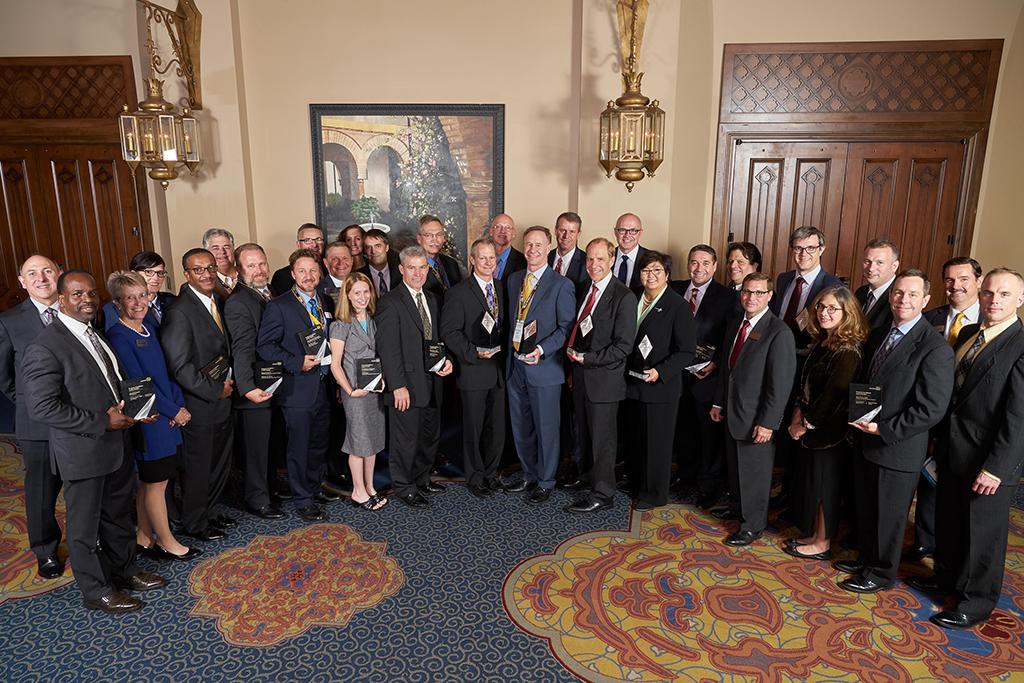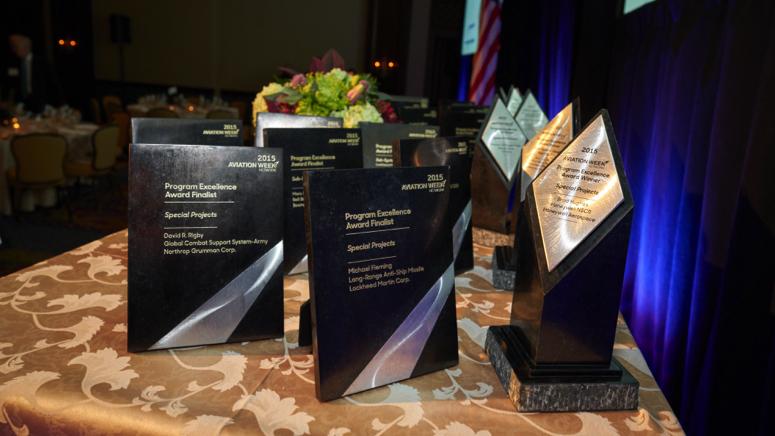
2016 Program Excellence Awards
Aviation Week’s 2016 Program Excellence winners, finalists and customers gathered for a group photo following the Oct. 26 banquet. The winners represent efforts across aerospace and defense, from cyber security and air traffic management to a telescope that will peer deeper into space than ever before.

Special Projects
National Cyber Range
Program Leader: Patrick Lardieri, Chief Engineering/Lockheed Martin Fellow
The National Cyber Range helps Defense Department development programs understand and mitigate their system’s cyberattack surface in a broad system-of-systems operational environment, and helps cyberwarriors train to defend U.S. systems against adversaries with constantly changing tactics and technology. Among the unique aspects of this Special Project was a unique measure—“willingness”—which was the gauge for acceptance of help on a topic that affects every program but that isn’t usually fully understood as a program necessity.

Subsystems R&D/SDD
James Webb Observatory Telescope Program
Program Leader: Scott C. Texter, Telescope Program Manager, Northrop Grumman
The Webb Telescope is intended to observe the birth and evolution of the first stars and galaxies, which came into existence after the Big Bang. In addition to developing this one-of-a-kind telescope, the team broke the cost/learning curve—the holy grail of program leadership. The telescope has, in effect, experienced an equivalent doubling of capability per unit cost, about every 4 years. Along the way to delivering to more than 13,000 requirements, the team refined best practices in supply chain teaming, handling and dispensing of risk, and putting into place predictive indicators to cover more than 50,000 logic-linked tasks.

Subsystem Level Production
Mars Atmosphere and Volatile Evolution Mission (MAVEN)
Program Leader: Guy Beutelschies, MAVEN Program Manager, Lockheed Martin
Long ago, Mars had rivers, lakes, and oceans; today it is a barren desert, indicating the atmosphere was once much thicker than it is today. The Mars Atmosphere and Volatile Evolution (MAVEN) mission is designed to figure out what happened to the Martian atmosphere. MAVEN represented an opportunity to demonstrate innovative management techniques for controlling costs. Planetary spacecraft are expected to meet all of their mission requirements, including the hard launch deadlines dictated by orbital mechanics. But to do so while under running budget by 8% is unprecedented. The team also worked to reduce complexity, while increasing the spacecraft’s flexibility in use.

Subsystem Level Sustainment
Javelin Joint Venture (JJV) Life Cycle Contract Support Program
Program Leaders: John Halvey, JJV President, Raytheon; and Richard Benton, JJV Vice President, Lockheed Martin
The program enabled successful missions in Southwest Asia, better than 99% mission reliability, and less than 2-day material availability while providing $45 million in savings over the past 2 years. The effort has a mix of both Firm-Fixed Price and Cost Plus Fixed Fee agreements. Modeling using real data from the previous contract versus directed Optempo and reliability failure projections allowed for extremely accurate supportability predictions—and improved overall performance.

System Level R&D/System Design and Development
Boeing’s MH-47G New Build
Chuck Dabundo, Vice President of Cargo Helicopter Programs/H-47 Program Manager, Boeing Defense Space & Security
This team developed and delivered its first aircraft in less than 24 months—to the delight of the team’s Special Operations Command customer. The team transformed older CH-47 aircraft into new, long range, assault aircraft. Using a new airframe baseline developed for Canada, the program team designed a monolithic frame, reducing manufacturing time but also increasing the airframe’s strength and “tuning” that frame to reduce vibration. The close work between SOCOM, Boeing and suppliers allowed suppliers to plan more realistically, reducing time and cost. The engineering team used a new digital design approach to reduce errors and interference while improving first-time quality. This digital approach became part of the team’s DNA—modeling provided visual context, and enabled virtual reviews as the team moved forward.

System Level Production
Mobile User Objective System Program
Program Leader: Iris Bombelyn, former MUOS program manager and current vice president of Protected Communications and Advanced EHF Programs, Lockheed Martin
This is the story of how a military space systems team dug deep into its commercial satellite roots, crafting a balanced approach to deliver on a fixed price commitment, achieving production efficiencies and extraordinary mission success. Lockheed Martin proceeded in advance of the contract options closure to acquire long-lead items at risk. This resulted in cost-per-hour savings, build over build, of 20-40% depending on the maturity/complexity of the part. Parts defects dropped 80% from first build to last. In addition, the satellite carries two payloads—one that is new-generation and a second that deals with legacy systems, providing an easy mode of transition. The team designed next-generation systems that took advantage of components, subsystems and spacecraft that were previously proven. Another philosophy was to provide opportunities for people to rotate within the program. Thus an engineer who started on the production floor could rotate into a systems engineering position on the program, and then support on-orbit mission test operations—creating a learning environment, but also keeping employees engaged with the mission.

System Level Sustainment
Aquila Air Traffic Management Services’ Project Marshall/UK Defense Ministry
Program Leader: Justin Barratt, managing director for Aquila Air Traffic Management Services
This program transformed terminal air traffic management for all UK Defense Ministry sites around the world to enable civil and military aircraft to operate safely in military terminal airspace with no loss of tactical freedom. Project Marshall combined 70 different projects into a single effort. The only requirement was output of flights handled, with no definition of the technology required included. With a combined effort from the Aquila program office, Thales and the UK’s National Air Traffic Systems, the team dramatically increased system availability and flight throughput, achieved required certification and has built in a process to continuously upgrade the operations. In all, Project Marshall has saved the British government £1 billion ($1.2 billion).

Group Trophies from 2015
Program Excellence Awards and plaques for finalists on display before the awards ceremony.
In today’s aerospace and defense environment, achieving excellence is no easy task. Programs are more complex, their technologies more advanced, their customers ever-more demanding.
Whether it’s guarding the borders, managing air traffic, designing an all-new system or sustaining an aircraft that has flown for decades, program managers continue to push to higher levels of employee engagement, to learn from the experience of others, and to carefully look at data and trends to determine what might happen.
And it is in this cloudy area of what might happen that true program leaders identify unknown risks. Or they see a gap, a glimmer of opportunity to make a system work better, boost a team to improved efficiency, or innovate a process or technology that will keep the program relevant.
